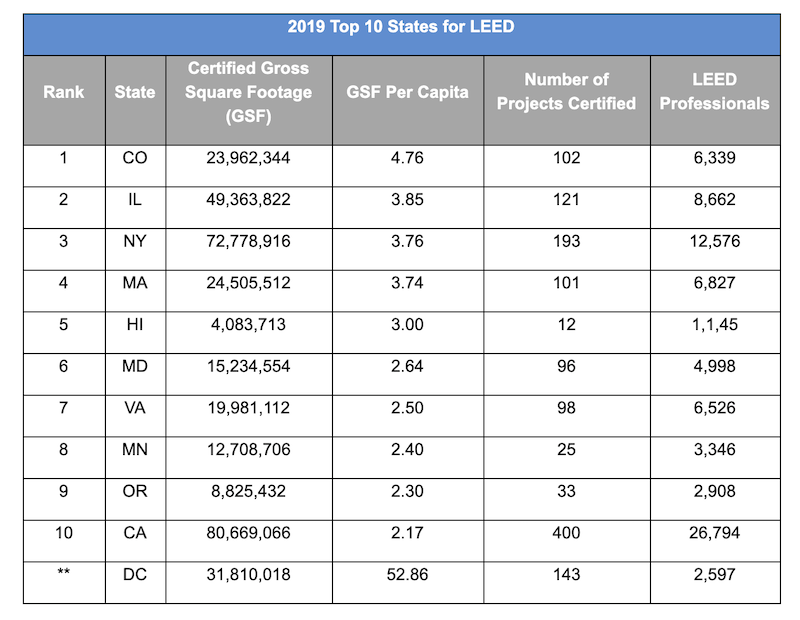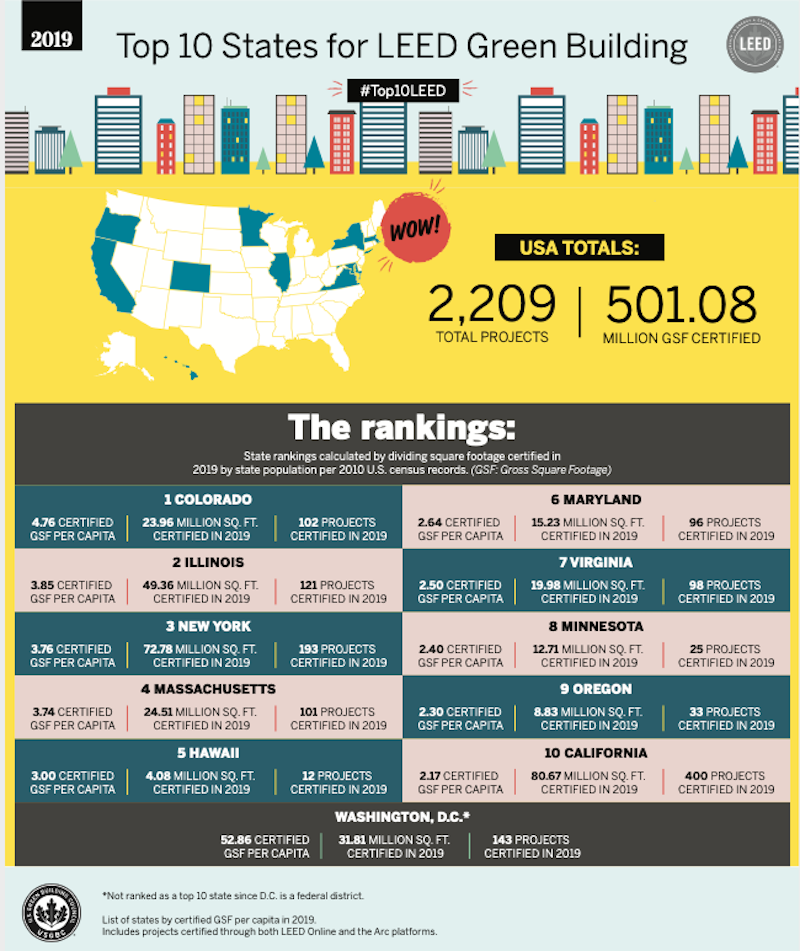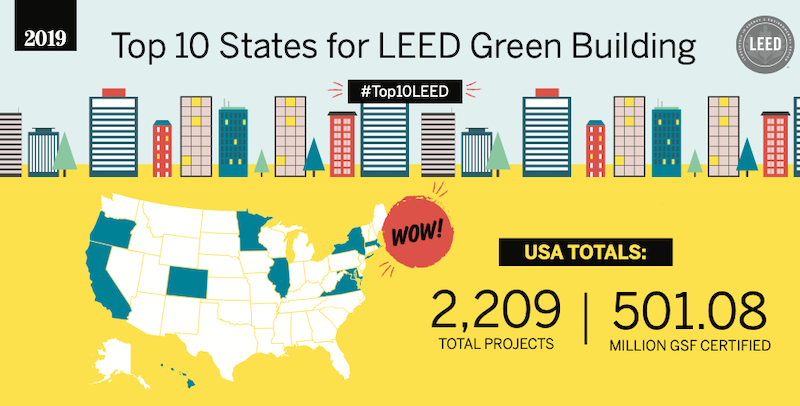As cities and states continue to work toward climate action goals, the U.S. Green Building Council (USGBC) has announced its list of Top 10 States for LEED green building. For the first time since 2011, Colorado took the top spot on the list, which ranks states based on the number of LEED certified square feet per person. LEED, or Leadership in Energy and Environmental Design, is the most widely used green building rating system in the world with more than 100,000 projects engaged. This year’s top states are home to more than 105 million people, including more than 80,000 LEED green building professionals with the skills to support the sustainable transformation of buildings.
“As we embark on a new decade, the USGBC community is focused on helping more projects get on the path to LEED certification and a more sustainable future,” said Mahesh Ramanujam, president and CEO, USGBC. “Over the last year, the Top 10 states have certified projects that serve as incredible examples of how green building can create more sustainable and resilient spaces that improve our living standard. There is still much work to be done, but the progress made across these states shows us that our work is having a tangible impact on people’s lives. As we enter our next chapter, we are committed to helping more buildings, cities and communities improve their sustainability performance through LEED.”
LEED-certified projects support personal health and well-being, as well as use less energy and water, reduce carbon emissions and save money for families, businesses and taxpayers. The Top 10 list is based on 2010 U.S. Census data and includes commercial and institutional green building projects certified throughout 2019. Colorado certified 102 green building projects representing 4.76 square feet of LEED-certified space per resident. The state has made the Top 10 list each year but jumped to the top spot after ranking sixth in 2018. Minnesota and Oregon reemerged as Top 10 states after missing the list last year, coming in at number eight and nine respectively. The full rankings are as follows:

USGBC calculates the list using per capita figures to allow for a fair comparison of the level of green building taking place among states with significant differences in population and number of overall buildings. Despite Washington, D.C. not appearing in the official Top 10 list because of its status as a federal territory, it consistently leads the nation and in 2019 certified 52.86 square feet of space per resident across 143 green building projects. The nation’s capital has a strong legacy of sustainability leadership and has expanded its use of LEED from buildings to cities and communities to support its goals. In 2017, it became the first LEED-certified city and in 2019 certified the Golden Triangle Business Improvement District LEED Platinum, the first business improvement district in the world to certify.
With green building expected to grow globally through 2021, the need for skilled professionals to support green building projects has never been more important. Across the U.S. there are more than 165,000 LEED green building professionals with the knowledge to help cities and communities transition to greener buildings and spaces. LEED professionals demonstrate a competency in green building principles that can set projects on the path to certification and help them consider ways to reduce their impact on the environment and provide people with healthier, more sustainable spaces to live, learn, work and play.

As USGBC continues to advance green buildings, cities and communities through the adoption of LEED and the latest version of the rating system, LEED v4.1, the organization is also considering a future that is focused on a more regenerative approach. In November 2019 at the annual Greenbuild International Conference & Expo, USGBC introduced LEED Positive – a roadmap that will lay the foundation for a future of LEED that transitions away from strategies that only reduce harm and instead focus on those that help repair and restore. With a continued focus on performance, USGBC is laying the groundwork to ensure sustainable design, construction and operations of buildings, cities and communities remains focused on better buildings that contribute to better lives.
Related Stories
Market Data | Oct 31, 2016
Nonresidential fixed investment expands again during solid third quarter
The acceleration in real GDP growth was driven by a combination of factors, including an upturn in exports, a smaller decrease in state and local government spending and an upturn in federal government spending, says ABC Chief Economist Anirban Basu.
Market Data | Oct 28, 2016
U.S. construction solid and stable in Q3 of 2016; Presidential election seen as influence on industry for 2017
Rider Levett Bucknall’s Third Quarter 2016 USA Construction Cost Report puts the complete spectrum of construction sectors and markets in perspective as it assesses the current state of the industry.
Industry Research | Oct 25, 2016
New HOK/CoreNet Global report explores impact of coworking on corporate real rstate
“Although coworking space makes up less than one percent of the world’s office space, it represents an important workforce trend and highlights the strong desire of today’s employees to have workplace choices, community and flexibility,” says Kay Sargent, Director of WorkPlace at HOK.
Market Data | Oct 24, 2016
New construction starts in 2017 to increase 5% to $713 billion
Dodge Outlook Report predicts moderate growth for most project types – single family housing, commercial and institutional building, and public works, while multifamily housing levels off and electric utilities/gas plants decline.
High-rise Construction | Oct 21, 2016
The world’s 100 tallest buildings: Which architects have designed the most?
Two firms stand well above the others when it comes to the number of tall buildings they have designed.
Market Data | Oct 19, 2016
Architecture Billings Index slips consecutive months for first time since 2012
“This recent backslide should act as a warning signal,” said AIA Chief Economist, Kermit Baker.
Market Data | Oct 11, 2016
Building design revenue topped $28 billion in 2015
Growing profitability at architecture firms has led to reinvestment and expansion
Market Data | Oct 4, 2016
Nonresidential spending slips in August
Public sector spending is declining faster than the private sector.
Industry Research | Oct 3, 2016
Structure Tone survey shows cost is still a major barrier to building green
Climate change, resilience and wellness are also growing concerns.
Industry Research | Sep 27, 2016
Sterling Risk Sentiment Index indicates risk exposure perception remains stable in construction industry
Nearly half (45%) of those polled say election year uncertainty has a negative effect on risk perception in the construction market.

















